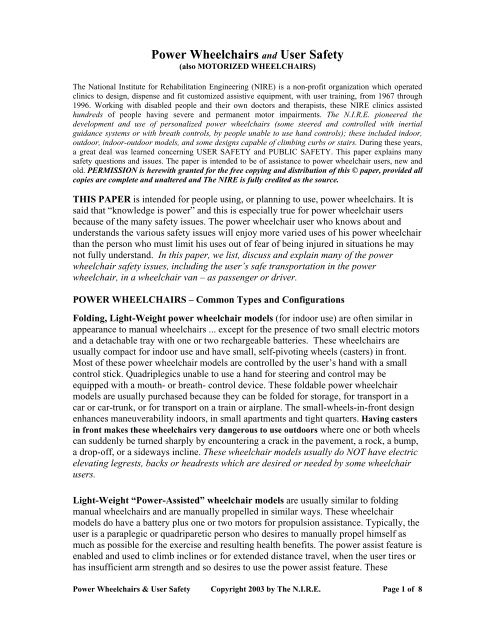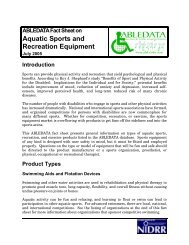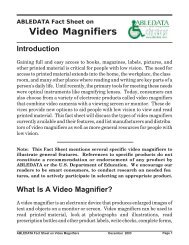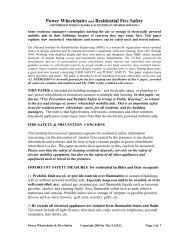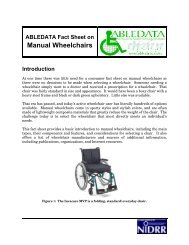Power Wheelchairs and User Safety - AbleData
Power Wheelchairs and User Safety - AbleData
Power Wheelchairs and User Safety - AbleData
You also want an ePaper? Increase the reach of your titles
YUMPU automatically turns print PDFs into web optimized ePapers that Google loves.
<strong>Power</strong> <strong>Wheelchairs</strong> <strong>and</strong> <strong>User</strong> <strong>Safety</strong><br />
(also MOTORIZED WHEELCHAIRS)<br />
The National Institute for Rehabilitation Engineering (NIRE) is a non-profit organization which operated<br />
clinics to design, dispense <strong>and</strong> fit customized assistive equipment, with user training, from 1967 through<br />
1996. Working with disabled people <strong>and</strong> their own doctors <strong>and</strong> therapists, these NIRE clinics assisted<br />
hundreds of people having severe <strong>and</strong> permanent motor impairments. The N.I.R.E. pioneered the<br />
development <strong>and</strong> use of personalized power wheelchairs (some steered <strong>and</strong> controlled with inertial<br />
guidance systems or with breath controls, by people unable to use h<strong>and</strong> controls); these included indoor,<br />
outdoor, indoor-outdoor models, <strong>and</strong> some designs capable of climbing curbs or stairs. During these years,<br />
a great deal was learned concerning USER SAFETY <strong>and</strong> PUBLIC SAFETY. This paper explains many<br />
safety questions <strong>and</strong> issues. The paper is intended to be of assistance to power wheelchair users, new <strong>and</strong><br />
old. PERMISSION is herewith granted for the free copying <strong>and</strong> distribution of this © paper, provided all<br />
copies are complete <strong>and</strong> unaltered <strong>and</strong> The NIRE is fully credited as the source.<br />
THIS PAPER is intended for people using, or planning to use, power wheelchairs. It is<br />
said that “knowledge is power” <strong>and</strong> this is especially true for power wheelchair users<br />
because of the many safety issues. The power wheelchair user who knows about <strong>and</strong><br />
underst<strong>and</strong>s the various safety issues will enjoy more varied uses of his power wheelchair<br />
than the person who must limit his uses out of fear of being injured in situations he may<br />
not fully underst<strong>and</strong>. In this paper, we list, discuss <strong>and</strong> explain many of the power<br />
wheelchair safety issues, including the user’s safe transportation in the power<br />
wheelchair, in a wheelchair van – as passenger or driver.<br />
POWER WHEELCHAIRS – Common Types <strong>and</strong> Configurations<br />
Folding, Light-Weight power wheelchair models (for indoor use) are often similar in<br />
appearance to manual wheelchairs ... except for the presence of two small electric motors<br />
<strong>and</strong> a detachable tray with one or two rechargeable batteries. These wheelchairs are<br />
usually compact for indoor use <strong>and</strong> have small, self-pivoting wheels (casters) in front.<br />
Most of these power wheelchair models are controlled by the user’s h<strong>and</strong> with a small<br />
control stick. Quadriplegics unable to use a h<strong>and</strong> for steering <strong>and</strong> control may be<br />
equipped with a mouth- or breath- control device. These foldable power wheelchair<br />
models are usually purchased because they can be folded for storage, for transport in a<br />
car or car-trunk, or for transport on a train or airplane. The small-wheels-in-front design<br />
enhances maneuverability indoors, in small apartments <strong>and</strong> tight quarters. Having casters<br />
in front makes these wheelchairs very dangerous to use outdoors where one or both wheels<br />
can suddenly be turned sharply by encountering a crack in the pavement, a rock, a bump,<br />
a drop-off, or a sideways incline. These wheelchair models usually do NOT have electric<br />
elevating legrests, backs or headrests which are desired or needed by some wheelchair<br />
users.<br />
Light-Weight “<strong>Power</strong>-Assisted” wheelchair models are usually similar to folding<br />
manual wheelchairs <strong>and</strong> are manually propelled in similar ways. These wheelchair<br />
models do have a battery plus one or two motors for propulsion assistance. Typically, the<br />
user is a paraplegic or quadriparetic person who desires to manually propel himself as<br />
much as possible for the exercise <strong>and</strong> resulting health benefits. The power assist feature is<br />
enabled <strong>and</strong> used to climb inclines or for extended distance travel, when the user tires or<br />
has insufficient arm strength <strong>and</strong> so desires to use the power assist feature. These<br />
<strong>Power</strong> <strong>Wheelchairs</strong> & <strong>User</strong> <strong>Safety</strong> Copyright 2003 by The N.I.R.E. Page 1 of 8
wheelchair models are often lighter-weight than the folding power wheelchair models<br />
discussed above because the intermittent power use allows for smaller battery <strong>and</strong> motor<br />
sizes.<br />
Non-Folding, St<strong>and</strong>-Up power wheelchair models (primarily for indoor use) are<br />
sometimes used by people, unable to st<strong>and</strong> unaided, so that they can be stood up by the<br />
wheelchair for household chores or to converse face-to-face with non-h<strong>and</strong>icapped<br />
people who are also st<strong>and</strong>ing. Generally, these models do not rely on swiveling front<br />
casters so that they are less maneuverable in small apartments (tight quarters) than<br />
conventional folding wheelchairs with casters. When in the elevated position, this type<br />
wheelchair has a very high center-of-gravity <strong>and</strong> can easily topple over. For this reason,<br />
the user of a “st<strong>and</strong>-up” power wheelchair should never put himself in the st<strong>and</strong>-up<br />
position when outdoors or even indoors, on cracked, rough or broken flooring indoors.<br />
St<strong>and</strong>-up wheelchairs are safe only on perfectly flat <strong>and</strong> smooth flooring, <strong>and</strong> only if the<br />
user is properly strapped to the seat <strong>and</strong> seat back. These wheelchair models sometimes<br />
have electric elevation of legrests, back or headrest, often helpful for quadriparetics or<br />
quadriplegics .<br />
Combination “Indoor-Outdoor” power wheelchair models are often purchased by<br />
people able to have <strong>and</strong> use only a single power wheelchair. Lack of storage space or<br />
limited finances can prevent the safer option: a person’s owning two power wheelchair<br />
models – one for optimum indoor use – <strong>and</strong> another for optimum outdoor use. Typically,<br />
the “Combination I/O” power wheelchair compromises both functions <strong>and</strong> performs<br />
poorly at each function due to various unavoidable safety limitations. Outdoor safety<br />
requirements usually require that large, powered wheels be in front. These “combo”<br />
wheelchairs are probably most useful <strong>and</strong> safe when used (1) outdoors, on pavements <strong>and</strong><br />
sidewalks in urban <strong>and</strong> suburban areas – not on grass or soil in rural areas; <strong>and</strong> (2)<br />
indoors, in nursing homes, assisted living facilities or apartments with wider halls <strong>and</strong><br />
doorways that facilitate the wheelchair with bigger turning radius <strong>and</strong> maneuvering space<br />
requirements. These wheelchair models sometimes have electric elevation of legrests,<br />
back or headrest, often helpful for quadriparetics or quadriplegics.<br />
Outdoor power wheelchair models were developed many years ago for use by people<br />
living in mostly rural countries such as Sweden. Very efficient outdoors, most have large<br />
diameter wheels in front to climb with ... <strong>and</strong> steering may be accomplished, depending<br />
on design: (1) by rotating a rear-wheel dolly ...or (2) by powering one of the large front<br />
wheels while braking the other. Many such power wheelchair models are able to safely<br />
climb grades of as much as 40%; climb curbs <strong>and</strong>, sometimes, climb outdoor stairs as<br />
seen in front of a courthouse or public building. (They do NOT climb stairs indoors due<br />
to the smaller steps <strong>and</strong> steeper grades.) These wheelchairs weigh as much as 400 to 500<br />
pounds, less the user – or up to 650 lbs. or more with the user. If they break down, a tow<br />
truck has to be called because of the weight. They sometimes can be used indoors in<br />
hotels, hospitals, nursing homes, or public buildings ... which all have wide corridors <strong>and</strong><br />
strong weight-bearing floors. Generally, these power wheelchairs are not safe or practical<br />
for use in an apartment. These wheelchair models sometimes have electric elevation of<br />
<strong>Power</strong> <strong>Wheelchairs</strong> & <strong>User</strong> <strong>Safety</strong> Copyright 2003 by The N.I.R.E. Page 2 of 8
legrests, back or headrest, often helpful for quadriparetics or quadriplegics. A few have<br />
optional elevating seats or st<strong>and</strong>-up features.<br />
Indoor Stair-Climbing power wheelchair models have been developed <strong>and</strong> tested over<br />
the past thirty years. The developers <strong>and</strong> manufacturers have generally been unable to<br />
obtain product liability insurance coverage <strong>and</strong>, thus, have not been able to market many<br />
of these products. Recently, the U.S. FDA approved yet another stair-climbing power<br />
wheelchair which has some very interesting <strong>and</strong> attractive design features. This stairclimber,<br />
as others before it, was designed for use in private homes <strong>and</strong> apartments as well<br />
as in public buildings. The earlier models, by other designers, were primarily for stairclimbing<br />
<strong>and</strong> were rather poor performers for general wheelchair use. The recently<br />
approved model appears to perform well in most wheelchair functions, as well as in<br />
climbing <strong>and</strong> descending stairs in private homes, in public buildings, <strong>and</strong> outdoors. These<br />
wheelchair models may or may not have electric elevation of legrests, back or headrest,<br />
often helpful for quadriparetics or quadriplegics.<br />
A BASIC DANGER OF STAIR-CLIMBING in a wheelchair is the fact that, if an occupied<br />
stair-climbing wheelchair falls down a flight of stairs (it could fall from near the top of a<br />
32-step stairway) then serious injury or death to the user is the likely. Others in the area<br />
may also be injured or killed.<br />
Each person considering the use of a stair-climbing power wheelchair should think about<br />
a lot of different variables, all of which interact with each other. These are just a few of<br />
the most significant of these important variables: (1) Does user have firm <strong>and</strong> immediate<br />
manual control of steering, braking <strong>and</strong> other wheelchair controls Examples: a<br />
paraplegic YES; a quadriplegic NO; users with MS or CP: variable – MAYBE – to what<br />
degree (2) Does user have sharp eyesight for spotting objects or defects on steps (3)<br />
Does user have engineering training or hobby experience in mechanics If not, can user<br />
underst<strong>and</strong> the dynamics of stair-climbing <strong>and</strong> learn to observe, analyze <strong>and</strong> think –<br />
before climbing stairs (4) Are the stairs to be climbed in the user’s home Are they<br />
stairs he has climbed <strong>and</strong> descended in the wheelchair time <strong>and</strong> time before Or, is it a<br />
new staircase not previously accessed (5) Has the user visually inspected the stairs<br />
before attempting to climb or descend them, for the presence of toys, clothing, <strong>and</strong> wet or<br />
damaged areas Any of these or other items could cause the wheelchair to fall. (6) Has<br />
the wheelchair user had someone else visually inspect the stairs for clutter, wet spots or<br />
damage before attempting to climb or descend (7) Has the wheelchair user been trained<br />
to climb <strong>and</strong> descend a particular flight of stairs by a professional such as the wheelchair<br />
engineer, or a therapist or a mobility trainer (8) Does the wheelchair user regularly<br />
climb or descend a new (to him) stairway on his own Or does he always have another<br />
experienced person evaluate the new stairway, first (9) Who is the first person to try<br />
climbing or descending a new stairway, in the power wheelchair The wheelchair user<br />
Or, his therapist, engineer or other proxy<br />
Age & Health Factors can be very significant to safety, both in preventing – <strong>and</strong> in<br />
surviving accidents. Examples: (1) Young paraplegic with normal upper body functions<br />
<strong>and</strong> strength. This fast moving person, with good eyesight, may well maneuver fast <strong>and</strong><br />
vigorously enough to prevent an accident. Even if his wheelchair turns over or falls over<br />
<strong>Power</strong> <strong>Wheelchairs</strong> & <strong>User</strong> <strong>Safety</strong> Copyright 2003 by The N.I.R.E. Page 3 of 8
an embankment, the person has the highest chance of surviving with minimal injuries. Or,<br />
(2) an elderly paraplegic, or a wheelchair user of any age with upper body weakness <strong>and</strong><br />
impaired movement abilities, is less likely to prevent an accident or fall at the last<br />
moment <strong>and</strong> is much more likely to suffer serious injuries or death in a fall, collision or<br />
accident.<br />
WHEELCHAIR Control Methods are also very significant to safety. Most power<br />
wheelchairs are controlled solely by the user, without intervention by computers, terrain<br />
monitors gyroscopes or autopilots. These power wheelchair models require, for safety,<br />
that the user quickly sense, recognize <strong>and</strong> react to each <strong>and</strong> every situation, as it arises.<br />
The young, healthy paraplegic will usually meet these requirements most rapidly <strong>and</strong><br />
effectively. The power wheelchair user with weak <strong>and</strong>/or slow-moving h<strong>and</strong> responses is<br />
more likely to have accidents <strong>and</strong> may be more severely injured. An ALTERNATIVE is<br />
available in some more costly power wheelchair models. This is the addition of<br />
computer-controlled systems that constantly monitor <strong>and</strong> correct for: wheelchair position<br />
<strong>and</strong> attitude; forward terrain variations; up <strong>and</strong> own stairway variations; user comm<strong>and</strong>s;<br />
<strong>and</strong> overall wheelchair performance. In theory, these power wheelchairs are much safer<br />
to operate than those without computer oversight. In practice, however, these power<br />
wheelchairs are sometimes more dangerous than non-computer wheelchairs. Serious<br />
accidents sometimes result from sensing or computer system failures. The failures may<br />
be subtle ones not recognized by the wheelchair user. Or, they can be in the form of a<br />
sudden, unexpected total failure of the wheelchair computer system, which may result in<br />
an accident when occurring at a critical time. Disregarding cost factors <strong>and</strong> considering<br />
safety issues alone, it is difficult to recommend the use of power wheelchairs that have –<br />
or that lack- computer monitoring <strong>and</strong> control capabilities. This type decision is best<br />
made with advice, on an individual basis, by each patient’s physician, therapist or<br />
mobility trainer. A “Dead-Man’s” safety control to automatically stop <strong>and</strong> brake the<br />
wheelchair if the user should let go of the wheelchair control stick or slump in his seat,<br />
can protect against accidents due to sudden loss of manual control or due to fainting or<br />
seizure. This feature is highly recommended <strong>and</strong> was included in most power wheelchairs<br />
dispensed by this Institute.<br />
USERS of <strong>Power</strong> <strong>Wheelchairs</strong> – DISABILITY CATEGORIES & SAFETY RISKS<br />
as summarized below, do not include the added hazards of navigating a power wheelchair<br />
with poor vision or with susceptibility to fainting or unexpected seizures. It is assumed<br />
that all wheelchair users are strapped in for safety. Two straps should be used: one, down,<br />
lap to chair – <strong>and</strong> the other higher up, securing the upper body to the backrest of the<br />
wheelchair. The power wheelchair user must be secured both ways for maximum<br />
safety.<br />
A) Paraplegics - Healthy, Fit & Active are typically the safest users of manual,<br />
power-assisted, <strong>and</strong> fully powered wheelchairs. LOWEST RISK<br />
B) Amputees – Missing Legs <strong>and</strong>/or Arms but with active upper bodies are usually<br />
safe users of power wheelchairs, depending on the type of control devices used.<br />
If planned <strong>and</strong> implemented properly, then LOW RISK.<br />
C) People with Weak or Poorly Controlled Upper Bodies using st<strong>and</strong>ard joystick<br />
to reliably control power wheelchairs. This category may include some people<br />
<strong>Power</strong> <strong>Wheelchairs</strong> & <strong>User</strong> <strong>Safety</strong> Copyright 2003 by The N.I.R.E. Page 4 of 8
with Cerebral Palsy, some with Multiple Sclerosis, some with Parkinson Disease,<br />
<strong>and</strong> people with many other conditions. Some of these conditions may cause<br />
impaired eyesight, slowed reflexes <strong>and</strong>/or impaired judgment. All should be fully<br />
screened for such functional deficits just as for automobile driving safety.<br />
MODERATE RISK.<br />
D) People with Little or No Upper Body Movement, using special quad controls<br />
such as mouth joystick, puff & sip breath control, or gyroscopic (inertial)<br />
wheelchair controls. HIGH RISK.<br />
E) Paralyzed Small People – Children <strong>and</strong> “very small” Adults ...in special seats<br />
or carriers often need a power wheelchair, most of all when significantly<br />
paralyzed. Depending on mechanical implementations, individual conditions, <strong>and</strong><br />
personalized mobility <strong>and</strong> safety training, these people are at HIGH RISK.<br />
SAFETY - INFORMATION ... for <strong>User</strong>s of <strong>Power</strong> <strong>Wheelchairs</strong><br />
1) Mechanical BRAKES that can be set or released by the wheelchair user<br />
are necessary safety items – an absolute “must” for outdoor wheelchair<br />
use. Some chairs have mechanical brakes that are h<strong>and</strong>-operated by a user<br />
with normal functioning of both h<strong>and</strong>s - but not by users with impaired<br />
h<strong>and</strong>s. Other chairs have no mechanical brakes but use “dynamic<br />
braking.” This helps slow the chair to a rapid stop when powered <strong>and</strong><br />
moving. It does NOT lock the wheels to prevent rolling down a steep incline.<br />
Buyers of power wheelchairs should always insist that the vendor includes<br />
mechanical brakes that the user can operate. They must be operable when<br />
moving, to brake, stop <strong>and</strong> lock the chair. And it must be possible for the<br />
wheelchair user to manually lock or to release the mechanical brakes ...<br />
when stopped. For quadriplegics unable to move a lever, it is feasible to<br />
use st<strong>and</strong>ard mechanical brakes that are set, locked <strong>and</strong> unlocked by small<br />
user-controllable electric motors.<br />
2) FRONT-WHEEL Configurations are very important for user safety.<br />
<strong>Power</strong> wheelchairs for outdoor use should always have powered large<br />
wheels in front; never free-swinging casters. Indoor wheelchairs with front<br />
casters are safe for outdoor use only on flat, level surfaces. They are at<br />
risk on sidewalks because of slab variations <strong>and</strong> irregularities, <strong>and</strong> totally<br />
unsafe on grass <strong>and</strong> soil. <strong>Wheelchairs</strong> with front casters are designed for<br />
indoor use because they offer better indoor maneuverability.<br />
3) USER ARM-STABILIZATION should be considered for the wheelchair<br />
user with impaired arm <strong>and</strong> h<strong>and</strong> function. An orthotic elbow or forearm<br />
support can be installed on the wheelchair to support the h<strong>and</strong> used to<br />
operate the wheelchair’s controls. This support can provide vital<br />
stabilization for the h<strong>and</strong> that steers <strong>and</strong> controls the power wheelchair.<br />
4) SAFETY SHUT-OFF & BRAKING CONTROLS should be provided<br />
for power wheelchair users who use mouth, breath, or other than h<strong>and</strong><br />
controls. The user with normal use of one h<strong>and</strong> can steer the power<br />
<strong>Power</strong> <strong>Wheelchairs</strong> & <strong>User</strong> <strong>Safety</strong> Copyright 2003 by The N.I.R.E. Page 5 of 8
wheelchair with the control stick, can operate auxiliary power control<br />
switches <strong>and</strong> can apply or release mechanical brakes. Quadriplegics<br />
should have special devices installed immediately to shut the power off<br />
<strong>and</strong> apply the brakes, if special sensors detect the wheelchair moving<br />
unsafely or out of control. The seller of the wheelchair <strong>and</strong> controls should<br />
include these safety features, which should be tested with the user <strong>and</strong> be<br />
approved by an occupational therapist..<br />
5) Traversing INCLINES – Always steer UP or DOWN an incline.<br />
NEVER travel across an incline ... because the wheelchair is likely to fall<br />
over, sideways, if you do. For wheelchairs with casters in front, avoid<br />
areas in the pavement or path that tilt to one side to avoid having the<br />
wheelchair roll off the path <strong>and</strong> over an embankment.<br />
6) Avoiding GROUND OBSTACLES to Wheels ... such as stones, cracks,<br />
curbs, etc. which must be seen <strong>and</strong> avoided by the wheelchair user to<br />
prevent sudden deflection of the wheelchair to one side, off the path.<br />
7) BATTERIES should be Fully Charged before leaving home. It is<br />
dangerous to be str<strong>and</strong>ed outdoors in a power wheelchair with dead<br />
batteries. Periodically, the batteries should be checked by a technician for<br />
proper fluid levels <strong>and</strong> for remaining charge capacities.<br />
8) Always have a CELL PHONE ... for safety. People with impaired h<strong>and</strong><br />
dexterity, unable to operate a st<strong>and</strong>ard cell phone, can have a cell phone<br />
attached to the wheelchair that is modified for use by even a quadriplegic.<br />
If you cannot afford monthly cell phone fees, then get a “911-only” cell<br />
phone for which there are no monthly charges. Cell phones should be<br />
wired to work from both internal battery <strong>and</strong> wheelchair battery. Electrical<br />
noise filters may be needed to suppress motor noise.<br />
9) <strong>Power</strong>ed VENTILATOR <strong>User</strong>s should have a separate rechargeable<br />
battery on the wheelchair, for the ventilator. This assures that the<br />
ventilator will not fail even if the power wheelchair battery is exhausted.<br />
There should be an audible alarm device <strong>and</strong> the wheelchair should have a<br />
cell phone or a 911 phone.<br />
10) Avoid RAIN <strong>and</strong> SNOW which are especially hazardous to power<br />
wheelchair users, <strong>and</strong> to their expensive equipment. Try to stay out of<br />
falling rain or snow; try to stay off wet, slippery surfaces coated with rain<br />
or snow. If you have to travel in rain or snow, use a wheelchair van, door<br />
to door.<br />
11) When being TRANSPORTED in a Wheelchair Van always make<br />
certain that: (a) the wheels of the wheelchair are locked to the floor of the<br />
van; (b) that the wheelchair undercarriage or seat is tightly strapped down<br />
to the floor. (c) that the wheelchair user is strapped DOWN to the seat –<br />
<strong>and</strong> BACK , from the chest to the seat’s back structure. Countless<br />
wheelchair users have been thrown forward, out of their chairs, into the<br />
<strong>Power</strong> <strong>Wheelchairs</strong> & <strong>User</strong> <strong>Safety</strong> Copyright 2003 by The N.I.R.E. Page 6 of 8
windshield <strong>and</strong> to their deaths because they did not follow these<br />
precautions. These must apply whether the van is privately owned, rented<br />
or a public for-hire service vehicle.<br />
12) Outdoor STAIR-CLIMBING <strong>Wheelchairs</strong>. Outdoor steps are usually<br />
wider, deeper <strong>and</strong> shallower than inside steps, <strong>and</strong> often of shorter height.<br />
Some outdoor power wheelchairs with large, powered wheels in front,<br />
are designed to safely carry the user up or down flights of outdoor steps,<br />
as found in front of courthouses or public buildings. These chairs cannot<br />
safely carry a person up or down the types of stairs found indoors, in<br />
homes, offices <strong>and</strong> public buildings. Never try on indoor stairways!<br />
13) Indoor STAIR-CLIMBING <strong>Wheelchairs</strong> are the most dangerous to use<br />
because indoor steps are steep, narrow, high <strong>and</strong> have short depths as<br />
compared with outdoor steps. Most indoor stairways are not designed to<br />
support heavy weight in one area <strong>and</strong> can crack or break without warning.<br />
Also, indoor steps often have poor visibility so that unseen clutter, wet<br />
spots <strong>and</strong> damaged areas can cause the heavy power wheelchair to slip,<br />
slide, lose its grip on the stairs, <strong>and</strong> crash to the bottom injuring or killing<br />
the user. CAUTION: Always have an able-bodied wheelchair technician<br />
or mobility trainer who is familiar with the stair-climber, test climb <strong>and</strong><br />
descend a particular flight of indoor stairs before the wheelchair user tries<br />
it. Even then, the wheelchair user should climb <strong>and</strong> then descend the same<br />
stairway two or three times in the presence of the technician or trainer.<br />
CAUTION: Stair-climbing wheelchairs may be unsafe in a private home<br />
because they are heavy. With batteries, such a wheelchair may weigh<br />
about 400 lbs. Add 200 lbs. for the user <strong>and</strong> the total weight can equal 600<br />
lbs. This is enough weight to crack, break or dislodge one or more steps,<br />
causing the wheelchair <strong>and</strong> user to fall down the entire flight of stairs.<br />
14) Periodic Preventive MAINTENANCE is absolutely necessary to<br />
maintain the safety of any power wheelchair, stair-climbing or not. We<br />
recommend daily minor, <strong>and</strong> weekly major inspections by the user. We<br />
also recommend a professional inspection at least once every 3 months for<br />
most users, <strong>and</strong> as often as once a month for very active <strong>and</strong>/or severely<br />
disabled users. If tires are air-inflated, air pressure should be checked<br />
before each day’s use. Solid tires should be visually inspected for breaks.<br />
For SAFETY, legal <strong>and</strong> financial reasons, it is recommended that all<br />
power wheelchair service be provided by the seller, by the manufacturer<br />
or by a local mechanic who is designated as a “manufacturer’s<br />
representative”.<br />
<strong>Power</strong> <strong>Wheelchairs</strong> & <strong>User</strong> <strong>Safety</strong> Copyright 2003 by The N.I.R.E. Page 7 of 8
For additional information or free technical support, please email: nire@warwick.net<br />
or contact us by regular mail or telephone.<br />
The National Institute for Rehabilitation Engineering<br />
Box 1088 – Hewitt, NJ 07421 U.S.A. Tel. (800) 736-2216<br />
Copyright 2003 by The National Institute for Rehabilitation Engineering<br />
(The N.I.R.E. is an IRS 501(c)3 organization helping people with disabilities)<br />
This paper may be freely copied <strong>and</strong> freely distributed provided all copies are complete <strong>and</strong> unaltered.<br />
<strong>Power</strong> <strong>Wheelchairs</strong> & <strong>User</strong> <strong>Safety</strong> Copyright 2003 by The N.I.R.E. Page 8 of 8


